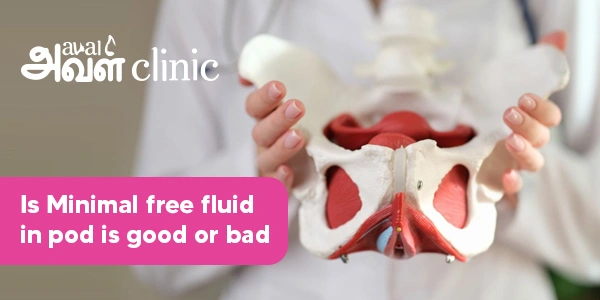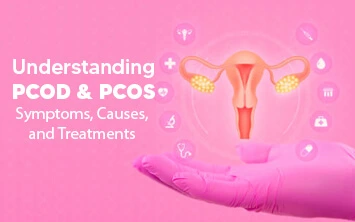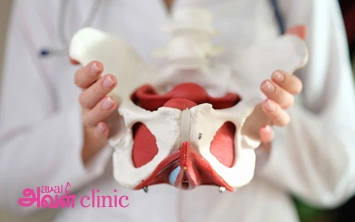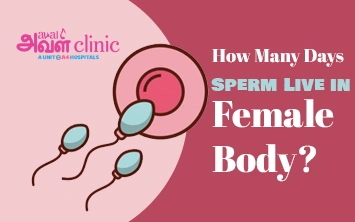Updated on: May 26, 2025
Author: Admin
The minimal free fluid is a small amount of fluid that naturally exists in the pelvic region of women, especially during their reproductive years. To be more exact, the fluid may precisely be present in the Pouch of Douglas (POD). POD is nothing but the region between the anterior rectum and the posterior uterus.
Minimal free fluid in POD (Pouch of Douglas) is a normal part of the woman’s anatomy. They are not generally considered an issue. As the name suggests, the free fluid is helpful for the pelvic organs like the uterus, rectum, fallopian tubes and more to move smoothly without any friction.
So, the simple answer to the question of whether minimal free fluid in pod is good or bad is obviously yes. It is healthy and good to have a sufficient amount of fluid in the pelvis.
In this blog, let’s discuss what the reasons are for minimal free fluid, its symptoms when the level increases or decreases, treatment options and so on.
What are the Reasons for Minimal Free Fluid in POD
The smaller amount or minimal free fluids in POD is a common finding, which may typically be around 100 ml. Whereas the larger amount of free fluids, which is more than 100 ml, can be a concern. The reasons for increasing level of the free fluid in POD can range between regular physiological changes and serious medical disorders. This may require medical support from healthcare providers like Aval Clinics, who are experts in well managing the condition.
Listed below are some of the reasons for increasing minimal free fluid in pelvis by physiological changes, which may include:
Physiological Changes
Physiological changes during the period, like ovulation, menstruation, and pregnancy, can significantly cause the mild free fluid in pod. Let’s have a more detailed look.
1. Ovulation
During ovulation, the level of free fluid is quite normal to increase as a consequence of the follicle rupturing and releasing the egg from the ovaries. This accumulation or mild increase in the level of free fluid is harmless. The excess fluid may typically be reabsorbed by the body without any treatment.
If you want to track your ovulation and better understand your cycle, you can use our Ovulation Calculator to find your most fertile days.
2. Normal fluid accumulation
Women, especially during their reproductive years, can be seen with minimal free fluid in their POD. As we already know that these fluids are helpful for the pelvic organs like the uterus, rectum, and fallopian tubes to move smoothly without any friction. The free fluid in pelvis of less than 100 ml in the abdominal scan report is considered to be healthy.
3. Menstruation
During menstruation, the increasing level of minimal free fluid in POD can be caused by menstrual flow through the fallopian tubes. The fluctuation in the fluid retention is indeed a normal physiological change and is harmless. However, the excessive fluid accumulation along with severe symptoms like pelvic pain, abdominal swelling, infection or fever are the clear indications that you need medical help.
To learn more about different menstrual irregularities, you can read about the 8 Types of Abnormal Menstruation.
4. Hormonal Changes
The increasing level of hormones, especially estrogen, has the tendency to enhance the vascular permeability. This, in turn, leads to an increase in the mild accumulation of free fluid in POD.
5. Early Pregnancy
During early pregnancy, it is normal to experience fluctuations. The fluid can be helpful for expectant mothers to move easily without any hassle. However, the excessive increase in the level of free fluid, especially if they are echogenic, is an indication of ectopic pregnancy or other underlying conditions. In such cases, having a consultation with the healthcare provider as soon as possible is highly suggested.
Pathological Changes
The increasing level of minimal free fluid can also be caused by certain pathological changes such as ruptured ovarian cysts, pelvic inflammatory diseases, ascites and so on.
Listed below are the detailed explanations for increasing minimal free fluid in the pelvis caused by pathological changes, which may include:
1. Ruptured Ovarian Cysts
Ovarian cysts are generally benign, which means non-cancerous tumours. They are formed either inside or on the surface of the ovaries. Some ovarian cysts have the tendency to rupture at a certain point. When this happens, it leads to an increasing level of free fluid in the pelvic cavity. However, the amount of fluid can vary depending on the size of the ruptured ovarian cysts.
2. Pelvic Inflammatory Disease (PID)
Pelvic inflammatory disease is a well-known type of condition caused by bacterial infections. They primarily affect the woman’s reproductive organs, like the fallopian tubes, uterus, and ovaries. The severe infection may result in forming pus, and sometimes even blood, in the pelvic region. The release of pus and blood can increase the amount of free fluid in the POD. The condition needs immediate medical help to prevent serious complications like infertility and scarring.
3. Ascites
Ascites is a medical condition in which fluid builds up in the peritoneal cavity. The peritoneal cavity is the region between the abdominal lining and the underlying organs. This contributes to the significant increase in the mild fluid in pod. Since ascites is a serious medical condition, it necessitates appropriate medical intervention.
4. Ectopic Pregnancy
An ectopic pregnancy is one of the serious pregnancy complications which needs medical intervention. This is because when a fertilised egg gets implanted in the fallopian tubes instead of the uterine lining. As the pregnancy progresses, the developing embryo has the possibility of rupturing the fallopian tubes. This may primarily lead to internal bleeding and increase the level of free fluid in the POD. It is highly recommended to have the medical intervention as soon as an ectopic pregnancy is diagnosed.
5. Trauma or Injury
Traumas caused without piercing the skin can contribute to the accumulation of free fluid in POD. In addition, injuries caused by accidents or falls can increase the level of free fluid in the pelvic region. In both scenarios, medical intervention is required to repair the damage or drain the fluid based on the severity of the condition.
Need Quick Help with Period Health?
Call Now: 80047 80048Symptoms of Minimal Free Fluid in POD
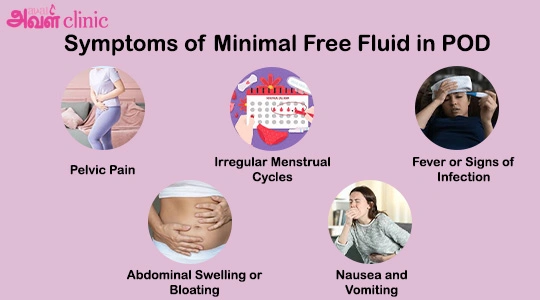
The symptoms of minimal free fluid in POD can widely range from normal to severe, depending on the amount of fluid accumulation and underlying cause. While mild accumulations are generally due to physiological changes, which are harmless and can be reabsorbed by the body. The larger accumulations may exhibit more complex symptoms, which may include:
Pelvic Pain
Pelvic pain is one of the most popular minimal free fluid in pelvis symptoms. Many women with increased fluid accumulation have described the pain to be persistent and sharp. The location of the pain may also widely vary from underlying conditions such as ectopic pregnancy and injury.
Abdominal Swelling or Bloating
The swelling in the abdomen is the most evident symptom of free fluid accumulation in the pelvic cavity. The symptom exhibits the feeling of heaviness in the woman.
Signs of Infection
Severe infections caused by uterine conditions like pelvic inflammatory diseases (PID) can increase the amount of free fluid in the POD. This contributes to exhibiting the symptoms of infection through chills, increased body temperature and heart rate.
Irregular Menstrual Cycles
Uterine conditions like ovarian cysts and pelvic inflammatory diseases (PID) can increase the amount of free fluid in the POD. These uterine conditions can also contribute to disrupting the menstrual cycle.
Nausea and Vomiting
Nausea and vomiting are mild symptoms. They may be significantly caused by internal bleeding. This may happen due to pathological conditions like ectopic pregnancy and severe injuries in the abdomen.
Diagnosing Minimal Free Fluid in POD
Many women may not recognise the free fluid accumulation in their pelvic organs until a diagnosis is made by the healthcare provider, soon after experiencing severe symptoms. Sometimes, the diagnosis of the condition may even be identified unintentionally when performing other tests. This happens in most scenarios, as the minimal fluid accumulation typically does not exhibit any symptoms.
The following are some of the diagnostic procedures performed by the healthcare provider to treat the condition.
Pelvic Ultrasound
A pelvic ultrasound is a popular medical method used to create images of the pelvis. The method is generally helpful to measure the amount and presence of fluid in the pelvic cavity.
CT Scan or MRI
CT scans or MRI are used only when the symptoms associated with the condition are severe. The procedure is helpful for the healthcare provider to appropriately diagnose the underlying cause of the condition. This happens as the method exhibits a clearer visualisation of the organs inside the pelvis.
Blood Tests
Your healthcare provider may suggest performing certain blood tests to identify the presence of infections and inflammation in the reproductive organs.
What are the Treatments available for Free Fluid in POD
Your healthcare provider may suggest the appropriate treatment plan depending on the severity and underlying cause of the fluid accumulation in POD. The following are some of the common options for treating the fluid accumulation in the pelvis region.
Observation and Monitoring
In certain physiological occurrences like ovulation and menstruation, a smaller amount of fluid may accumulate in the pelvic cavity. They are generally harmless and don’t require any medical intervention, as these fluids are reabsorbed by the body over time. In such scenarios, your healthcare provider may usually suggest observing and monitoring the level of free fluids.
Medications
Medications are most significantly prescribed in pathological occurrences like uterine conditions and infections. Your healthcare provider may certainly prescribe hormonal medications to help with regulating the symptoms associated with the condition. This will also help with potentially reducing the negative impact of increasing the free fluids.
Surgical Interventions
Surgical interventions are recommended by the healthcare professional in severe and complicated scenarios. To treat such severe conditions, procedures like laparoscopy and paracentesis are performed.
1. Laparoscopy
Laparoscopy is a less invasive procedure, which is generally performed as a day-care treatment. Using the procedure, the healthcare provider may diagnose and treat the conditions by making small incisions in the abdomen. The procedure may include repairing the pelvic organs, removing cysts, or treating ectopic pregnancies.
2. Paracentesis
Similar to laparoscopy, paracentesis is a medical method that is used in both diagnosing and therapeutic purposes. The healthcare provider may use the technique to drain the excessive amount of fluids from both the pelvic and abdominal cavity.
Summary
The accumulation of free fluid in the POD (Pouch of Douglas) is a usual part of a woman’s anatomy. They are harmless, and in fact, they act as a lubricant for the easy movement of the pelvic organs without any friction. The absence of no free fluid in pod means the sign of medical conditions like endometriosis, along with scarring.
Whether you experience the absence of free fluid or an excessive amount of free fluid, it is best to get evaluated by a healthcare provider. With the most appropriate diagnosis and treatment, the condition can be managed most effectively. And, of course, with certain lifestyle modifications.
If you still have any concerns, having a consultation with experts at Aval Clinics is recommended. They can guide you.
Contact us today for expert advice and personalized care:

